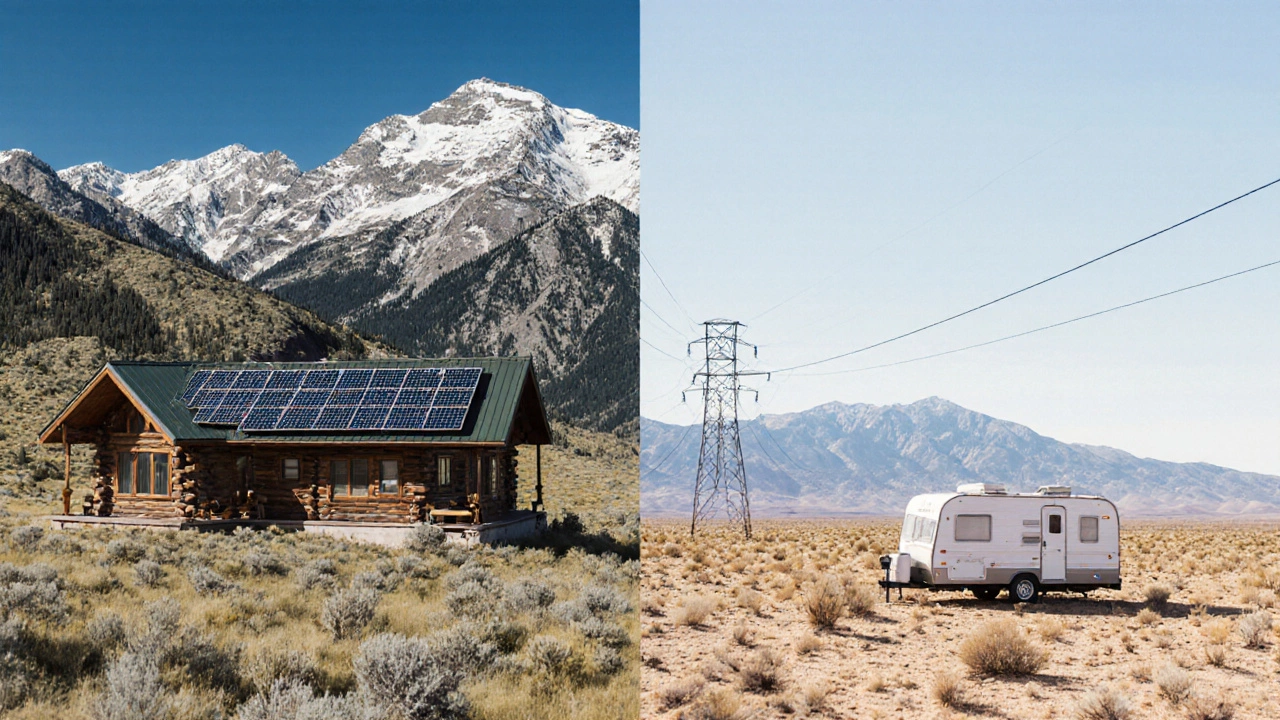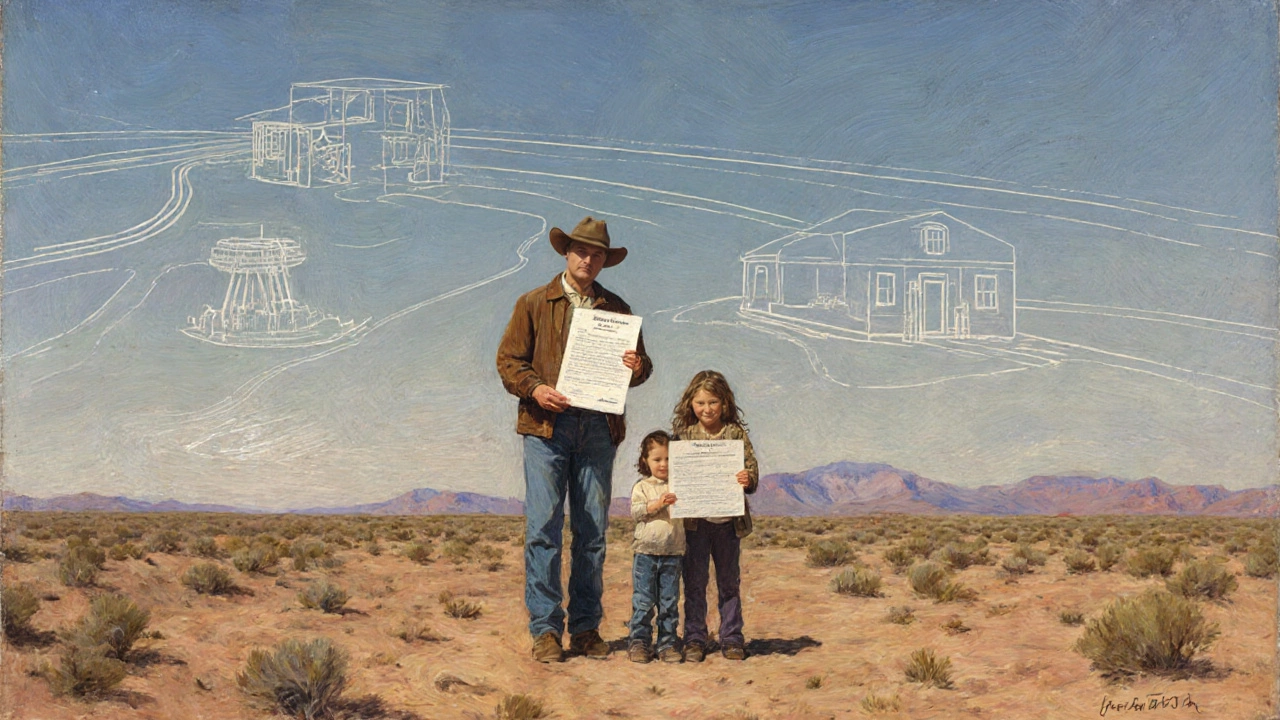Is Utah a wealthy state? Here’s what the data says about income, land prices, and cost of living

Nov, 13 2025
Utah Land Value Estimator
Land Value Calculator
Calculate true land costs in Utah by considering hidden expenses like water access, infrastructure, and zoning.
Total Estimated Investment
Critical Considerations
When people ask if Utah is a wealthy state, they’re often really asking: Is it worth buying land here? The answer isn’t simple. Utah has booming cities, low unemployment, and some of the fastest-growing counties in the U.S. But it also has rural areas where poverty rates are higher than the national average. The truth? Utah’s wealth is uneven-and that directly affects land prices, who can afford it, and where the best deals are.
Utah’s median household income is above average, but not as high as you think
In 2024, Utah’s median household income was $81,300, according to the U.S. Census Bureau. That’s about 12% higher than the national median of $72,500. Sounds good, right? But here’s the catch: Utah’s cost of living isn’t just high-it’s rising faster than incomes in many areas.
Take Salt Lake City. A family making $80,000 a year is considered middle-class. But if you’re trying to buy even a modest 2,000-square-foot home on a half-acre lot in the suburbs, you’re looking at $600,000 to $750,000. That’s more than double what it cost in 2019. Meanwhile, in rural counties like Piute or Wayne, median incomes drop to $55,000 or less. Land there might cost $15,000 an acre-but you’re not getting water rights, internet, or a reliable power grid.
Land prices tell the real story
If you’re looking at land for sale in Utah, you’re not just buying dirt. You’re buying access-to water, to roads, to zoning rules, and to future appreciation. In Wasatch County, near Park City, raw land sold for $12,000 per acre in 2020. By 2025, that same land was going for $85,000 per acre if it had even partial water rights. In contrast, in the high desert of Emery County, you can still find 10-acre parcels for under $10,000. But those parcels don’t have wells, septic approval, or cell service.
Why the gap? Demand. Utah added over 400,000 new residents between 2019 and 2024. Most moved to the Wasatch Front-Salt Lake, Provo, Ogden. That’s where land prices exploded. Outside that corridor, the market is flat or even declining. So if you’re thinking of buying land as an investment, location isn’t just important-it’s everything.

Who’s actually wealthy in Utah?
Utah has the highest percentage of households with two income earners in the U.S. That’s not because people make more money-it’s because nearly every family has two people working. The state also has the lowest percentage of single-parent households, which helps keep poverty rates lower than you’d expect for a state with a young population.
But wealth isn’t evenly spread. The top 10% of earners in Utah make over $220,000 a year. That’s the same as the top 10% in California. But the bottom 20%? They make less than $28,000. That’s below the federal poverty line for a family of four. And here’s the kicker: Utah’s housing shortage means low-income families are being pushed farther out-into areas with no schools, no jobs, and no public transit.
That’s why you’ll see land for sale in places like Tooele or Juab County that’s cheap-but only because no one wants to live there. The land isn’t cheap because it’s undervalued. It’s cheap because it’s isolated.
Utah’s economy is strong-but it’s built on a few pillars
Utah doesn’t have Silicon Valley. It doesn’t have Wall Street. But it does have tech. Adobe, Qualtrics, and over 1,200 software companies call Utah home. The state has the highest percentage of workers in tech jobs outside of Washington and California. That’s why median wages in Salt Lake County are rising faster than in any other part of the state.
But that’s only part of the picture. Utah also has one of the highest rates of self-employment in the country. Many people run small businesses-outdoor gear shops, home-based contractors, local farms. These aren’t high-paying jobs, but they’re stable. And they’re why you’ll find so much undeveloped land in the Wasatch Back: people buying 5-acre plots to build cabins, raise goats, or start micro-farms.
That’s the real Utah: a mix of corporate tech wealth and quiet, self-sufficient living. The land you buy depends on which side you’re on.

What does this mean for land buyers?
If you’re looking to buy land in Utah, here’s what you need to know:
- Don’t chase cheap land near cities. If it’s under $50,000 for 5 acres and within 30 miles of Salt Lake or Provo, it’s probably zoned for agriculture or has no building permits. You’ll spend more fixing it than you saved buying it.
- Water rights are worth more than the land. In Utah, water is legally tied to the land. A parcel with documented water rights can be 5x more valuable than one without-even if they’re side by side.
- Check the county’s development plan. Some counties, like Summit or Washington, are actively encouraging growth. Others, like Daggett or San Juan, are trying to stay rural. That affects future value.
- Don’t assume tax breaks mean affordability. Utah has low property taxes, but that doesn’t mean you can afford the land. Many buyers get shocked when they realize they need $20,000 just to drill a well and install a septic system.
The smartest buyers aren’t looking for the cheapest land. They’re looking for land that’s legally buildable, has access to utilities, and is in a county that’s growing. That’s where the real wealth is being built.
Utah isn’t rich-it’s growing fast, and that’s different
Utah isn’t a state full of billionaires. It doesn’t have the wealth of Massachusetts or the tech riches of California. But it has something rarer: momentum. People are moving here. Jobs are being created. Schools are expanding. Infrastructure is improving.
That’s why land in the right place is a good bet. Not because Utah is wealthy-but because it’s becoming more connected, more populated, and more valuable. The trick is knowing where to look.
Buy land near a growing town with good schools and a clear water source. Avoid the desert edges unless you’re ready to live off-grid for a decade. And never assume low prices mean low risk. In Utah, the cheapest land often comes with the highest hidden costs.
Is Utah a rich state compared to other western states?
Utah ranks in the top 10 for median household income among U.S. states, but it’s not among the wealthiest in the West. California, Washington, and Colorado all have higher median incomes. However, Utah’s cost of living is significantly lower than California’s and slightly lower than Colorado’s, making it more affordable for middle-income families. The state’s wealth is more evenly distributed than in coastal states, but the gap between high earners and low earners is growing.
Why is land so expensive in some parts of Utah but cheap in others?
Land prices in Utah are driven by proximity to urban centers and access to infrastructure. Land near Salt Lake City, Park City, or Provo is expensive because of demand from people moving in and limited supply. In contrast, land in remote counties like San Juan or Daggett is cheap because it lacks water, roads, power, and internet. The difference isn’t about the land itself-it’s about what you can do with it.
Can you live affordably on cheap land in Utah?
You can, but it’s not easy. Buying 10 acres for $8,000 in a remote area sounds like a bargain-until you realize you need to haul water, install a solar system, build a septic tank, and drive 45 minutes to the nearest grocery store. Many people who try this end up spending $50,000-$100,000 just to make the land livable. Unless you’re skilled in off-grid living, it’s rarely cheaper than buying a small home in a town.
Is Utah land a good investment in 2025?
Yes-if you buy in the right place. Land in counties with population growth, approved zoning for residential use, and access to utilities has appreciated 15-25% annually over the last five years. Land in isolated areas with no development plans has barely moved. The key is location, access, and legal permissions-not price. The best investments are in areas where the county is actively planning infrastructure upgrades.
What hidden costs come with buying land in Utah?
Many buyers forget about well drilling ($10,000-$25,000), septic system installation ($8,000-$15,000), road access permits, and utility hookups. In some areas, you also need to pay for a land survey, environmental review, or soil test. Property taxes are low, but these upfront costs can add up to more than the land price itself. Always get a professional inspection before buying.